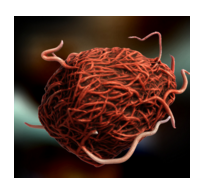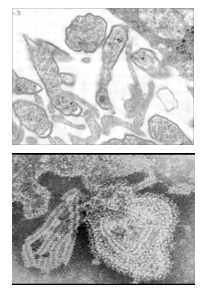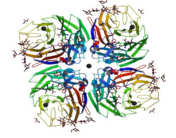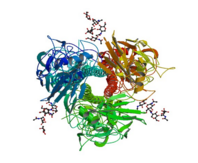Gloria Adubofour/Sandbox 2
From Proteopedia
Contents |
Mumps Virus Hemagglutinin Neuraminidase Protein
Disease
Mumps is a common contagious childhood disease characterized by swelling of the parotid glands, salivary glands and other epithelial tissues. The causative agent of mumps is an RNA-enveloped virus that belongs to Rubulavirus in the Paramyxoviridae family (Figure 1). The virion particles of this virus appears under the electron microscope as either spherical or pleiomorphic with about 200 nm diameter as shown in figure 2. Likewise, the genome is found in a negative-strand RNA with 15384 nucleotides in length. Mumps results in high morbidity and deafness in some serious cases. The virus is transmitted by direct contact, droplet spread and through contaminated objects[1]. Humans are the only known natural hosts of the virus [2].
Structure
The HN protein has three functions in which it recognizes the sialic acid-containing receptors on the surface of the cell, it improves the activity of the fusion protein to allow the virus to diffuse to the surface of the cell, and it functions as a neuraminidase (sialidase) to prevent the virus from self-agglutination. Thus, due to its multifunctional actions, the HN protein is an important target for structure-based drug design for paramyxovirus diseases [3].
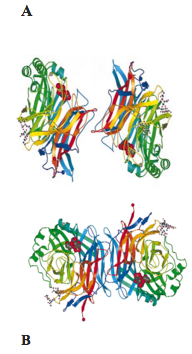
As was mentioned before, hemagglutinin-neuraminidase(HN) protein is a combination of two proteins in mumps virus that are similar to those in influenza but are separated in this case. Neuraminidase is a viral enzyme that prevents the spread of influenza virus infection and it is found on the surface of the virus and is made up of 582 amino acids. Likewise, there are two major types of neuraminidase enzymes, the endo- and exo-glycosidase activity, and they are known as endo-neuraminidase and exo-neuraminidase. The endo-neuraminidase catalyses the endohydrolysis of (2→8)-α-sialosyl linkages in oligosialic(sialic)acid or polysialic(sialic)acid. The exo-neuraminidase catalyses the hydrolysis of α-(2→3)-, α-(2→6)-,α-(2→8)-glycosidic linkages of sialic acid residues in oligosaccharides, glycoproteins, glycolipids and synthetic substrates. Neuraminidase is found on the surface of the influenza virus and consists of four co-planar and spherical subunits which form a mushroom shape as shown in figure 4. The hydrophobic region of neuraminidase is made of 29 amino acids that are anchored to the membrane of the virus and includes a single polypeptide chain that is found in the opposite side to the hemagglutinin antigen. The polypeptide is made of a single chain of six polar amino acids followed by different hydrophilic amino acids. The predominant secondary structure of the conformation of the protein is β-Sheets and two strains of N2, two strains of N9 and 1 type B strain are known for this protein [4][5] [6].
Hemagglutinin makes up 80% of the glycoproteins of the mumps virus. The hemagglutinin, H, is a transmembrane protein and so is able to transport molecules across the membrane layer [7]. Though there are 16 antigenically different types of hemagglutinin, only 6 subtypes are known to infect humans. Out of these 6 subtypes, H1, H2 and H3 are the ones that are able to spread from human to human efficiently [8]. Hemagglutinin is a single polypeptide composed of 567 amino acids, which codes for the H1 chain made of 329 amino acids and the H2 also consisting 221 amino acids [9]. H1 contains sialic acid-binding sites which it uses to attach to the host cell. The H2 forms a membrane-spanning anchor known as a fusion peptide, which is directly involved in the fusion mechanism. H1 and H2 are linked by a disulfide bond between two cysteines [10].
Mechanism of Infection
Hemagglutinin-neuraminidase(HN) is the protein that allows the virus to attach to sialic-acid cell receptors. Then, the virus is able to enter the plasma membrane of the host cells by fusing. The HN protein interacts with the fusion (F) protein to induce a membrane fusion [11]. Further, this protein combines the two proteins’ activities, the hemagglutinin and neuraminidase. Compared to the proteins in influenza which work separately, this protein (HN) works as a single viral protein. The function of the neuraminidase is to ensure that the virus spreads by dissociating the mature virions from the neuraminic acid containing glycoproteins. Mumps hemagglutinin has some similarities with influenza hemagglutinin: they both have a six-bladed beta propeller structure as shown in figure 3. The beta propeller structure is important for pH based conformational changes [12].
References
- ↑ Hviid, A.; Rubin, S.; Mühlemann, K. Mumps. The Lancet 2008, 371, 932-944
- ↑ "Mumps." WHO. WHO, 2016. Web. 08 Apr. 2016
- ↑ Zaitsev, V.; Von Itzstein, M.; Groves, D.; Kiefel, M.; Takimoto, T.; Portner, A.; Taylor, G. Second Sialic Acid Binding Site in Newcastle Disease Virus Hemagglutinin-Neuraminidase: Implications for Fusion. J. Virol. 2004, 78, 3733-3741
- ↑ Palese, P.; Tobita, K.; Ueda, M.; Compans, R. W. Characterization of temperature sensitive influenza virus mutants defective in neuraminidase. Virology 1974, 61, 397-410
- ↑ Schmidt, P. M.; Attwood, R. M.; Mohr, P. G.; Barrett, S. A.; McKimm-Breschkin, J. L. A generic system for the expression and purification of soluble and stable influenza neuraminidase. PLoS ONE 2011, 6
- ↑ Colman, P. M. Influenza virus neuraminidase: Structure, antibodies, and inhibitors. Protein Sci. 1994, 3, 1687-1696
- ↑ Alberts, B.; Lewis, J.; Raff, M.; Roberts, K.; Walter, P.; Molecular Biology of the Cell, 4th edition, Garland Science, 2002
- ↑ Shors, T. (2013) Influenza Viruses, Understanding Viruses. 2nd edition, 355-361
- ↑ Alberts, B.; Lewis, J.; Raff, M.; Roberts, K.; Walter, P.; Molecular Biology of the Cell, 4th edition, Garland Science, 2002
- ↑ Shors, T. (2013) Influenza Viruses, Understanding Viruses. 2nd edition, 355-361
- ↑ Takimoto, T.; Taylor, G. L.; Connaris, H. C.; Crennell, S. J.; Portner, A. Role of the hemagglutinin-neuraminidase protein in the mechanism of paramyxovirus-cell membrane fusion. J. Virol. 2002, 76, 13028-13033
- ↑ Lawrence, M. C.; Borg, N. A.; Streltsov, V. A.; Pilling, P. A.; Epa, V. C.; Varghese, J. N.; McKimm-Breschkin, J. L.; Colman, P. M. Structure of the Haemagglutinin-neuraminidase from Human Parainfluenza Virus Type III. J. Mol. Biol.2004, 335, 1343-1357
